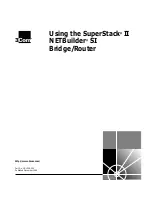
AWK-3131A-M12-RCC
Web Console Configuration
3-32
Forwarding delay
Setting
Description
Factory Default
Numerical value input
by user
(4 – 30 seconds)
The amount of time this device waits before checking to see if it
should change to a different topology.
15 (seconds)
Max. age
Setting
Description
Factory Default
Numerical value input
by user
(6 – 40 seconds)
As a non-root role, if the device has not received a hello
message from the root longer than Max. age, it will reconfigure
itself as a root. Once two or more devices on the network are
recognized as a root, the devices will renegotiate to set up a
new Spanning Tree topology.
20 (seconds)
Enable RSTP
Setting
Description
Factory Default
Enable/ disable
Enables or disables the port as a node on the Spanning Tree
topology.
Disable
(unchecked)
Port priority
Setting
Description
Factory Default
Numerical value
selected by user
Increase this port’s priority as a node on the Spanning Tree
topology by inputting a lower number.
128
Port cost
Setting
Description
Factory Default
Enable/ Disable
Input a higher cost to indicate that this port is less suitable as a
node for the Spanning Tree topology
2000000
Edge port
Setting
Description
Factory Default
Checked/ unchecked
Sets a port, which no BPDU expectedly goes through, as an
edge port
unchecked, except
AP port
NOTE
We recommend you set an edge port for the port, which is connected to a non-STP/RSTP sub-network or an
end device (PLC, RTU, etc.) as opposed to network equipment. This can prevent unnecessary waiting and
negotiation of STP/RSTP protocol, and accelerate system initialization. When an edge port receives BPDUs, it
can still function as an STP/RSTP port and start negotiation.
Setting an edge port is different from disabling STP/RSTP on a port. If you disable STP/RSTP, a port will not
deal with STP/RSTP BPDUs at all.
Port Status
Port Status indicates the current Spanning Tree status of this port. Use Forwarding for normal transmission,
or Blocking to block transmission.
















































